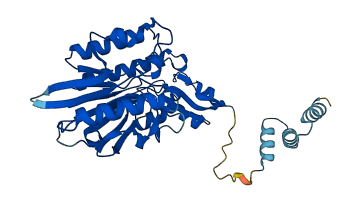Q58719
Gene name |
mre11 |
Protein name |
DNA double-strand break repair protein Mre11 |
Names |
|
Species |
Methanocaldococcus jannaschii (strain ATCC 43067 / DSM 2661 / JAL-1 / JCM 10045 / NBRC 100440) (Methanococcus jannaschii) |
KEGG Pathway |
mja:MJ_1323 |
EC number |
|
Protein Class |
|

Descriptions
Autoinhibitory domains (AIDs)
Target domain |
2-208 (Nuclease domain) |
Relief mechanism |
Partner binding |
Assay |
|
Accessory elements
No accessory elements
Autoinhibited structure

Activated structure

7 structures for Q58719
No variants for Q58719
| Variant ID(s) | Position | Change | Description | Diseaes Association | Provenance |
|---|---|---|---|---|---|
| No variants for Q58719 | |||||
No associated diseases with Q58719
No GO annotations of cellular component
| Name | Definition |
|---|---|
| No GO annotations for cellular component |
8 GO annotations of molecular function
| Name | Definition |
|---|---|
| 3'-5' exonuclease activity | Catalysis of the hydrolysis of ester linkages within nucleic acids by removing nucleotide residues from the 3' end. |
| DNA binding | Any molecular function by which a gene product interacts selectively and non-covalently with DNA (deoxyribonucleic acid). |
| DNA end binding | Binding to DNA ends exposed by the creation of double-strand breaks (DSBs). |
| endonuclease activity | Catalysis of the hydrolysis of ester linkages within nucleic acids by creating internal breaks. |
| exodeoxyribonuclease activity | Catalysis of the sequential cleavage of mononucleotides from a free 5' or 3' terminus of a DNA molecule. |
| identical protein binding | Binding to an identical protein or proteins. |
| manganese ion binding | Binding to a manganese ion (Mn). |
| Y-form DNA binding | Binding to a DNA segment shaped like a Y. This shape occurs when DNA contains a region of paired double-stranded DNA on one end and a region of unpaired DNA strands on the opposite end. |
2 GO annotations of biological process
| Name | Definition |
|---|---|
| DNA repair | The process of restoring DNA after damage. Genomes are subject to damage by chemical and physical agents in the environment (e.g. UV and ionizing radiations, chemical mutagens, fungal and bacterial toxins, etc.) and by free radicals or alkylating agents endogenously generated in metabolism. DNA is also damaged because of errors during its replication. A variety of different DNA repair pathways have been reported that include direct reversal, base excision repair, nucleotide excision repair, photoreactivation, bypass, double-strand break repair pathway, and mismatch repair pathway. |
| double-strand break repair | The repair of double-strand breaks in DNA via homologous and nonhomologous mechanisms to reform a continuous DNA helix. |
No homologous proteins in AiPD
| UniProt AC | Gene Name | Protein Name | Species | Evidence Code |
|---|---|---|---|---|
| No homologous proteins | ||||
| 10 | 20 | 30 | 40 | 50 | 60 |
| MMFVHIADNH | LGYRQYNLDD | REKDIYDSFK | LCIKKILEIK | PDVVLHSGDL | FNDLRPPVKA |
| 70 | 80 | 90 | 100 | 110 | 120 |
| LRIAMQAFKK | LHENNIKVYI | VAGNHEMPRR | LGEESPLALL | KDYVKILDGK | DVINVNGEEI |
| 130 | 140 | 150 | 160 | 170 | 180 |
| FICGTYYHKK | SKREEMLDKL | KNFESEAKNY | KKKILMLHQG | INPYIPLDYE | LEHFDLPKFS |
| 190 | 200 | 210 | 220 | 230 | 240 |
| YYALGHIHKR | ILERFNDGIL | AYSGSTEIIY | RNEYEDYKKE | GKGFYLVDFS | GNDLDISDIE |
| 250 | 260 | 270 | 280 | 290 | 300 |
| KIDIECREFV | EVNIKDKKSF | NEAVNKIERC | KNKPVVFGKI | KREFKPWFDT | LKDKILINKA |
| 310 | 320 | 330 | 340 | 350 | 360 |
| IIVDDEFIDM | PDNVDIESLN | IKELLVDYAN | RQGIDGDLVL | SLYKALLNNE | NWKELLDEYY |
| NTKFRG |